Cite this document
(Exploring the Reliability and Validity of the Methods: Randomization Essay - 33, n.d.)
Exploring the Reliability and Validity of the Methods: Randomization Essay - 33. https://studentshare.org/health-sciences-medicine/1811903-essay
Exploring the Reliability and Validity of the Methods: Randomization Essay - 33. https://studentshare.org/health-sciences-medicine/1811903-essay
(Exploring the Reliability and Validity of the Methods: Randomization Essay - 33)
Exploring the Reliability and Validity of the Methods: Randomization Essay - 33. https://studentshare.org/health-sciences-medicine/1811903-essay.
Exploring the Reliability and Validity of the Methods: Randomization Essay - 33. https://studentshare.org/health-sciences-medicine/1811903-essay.
“Exploring the Reliability and Validity of the Methods: Randomization Essay - 33”. https://studentshare.org/health-sciences-medicine/1811903-essay.


